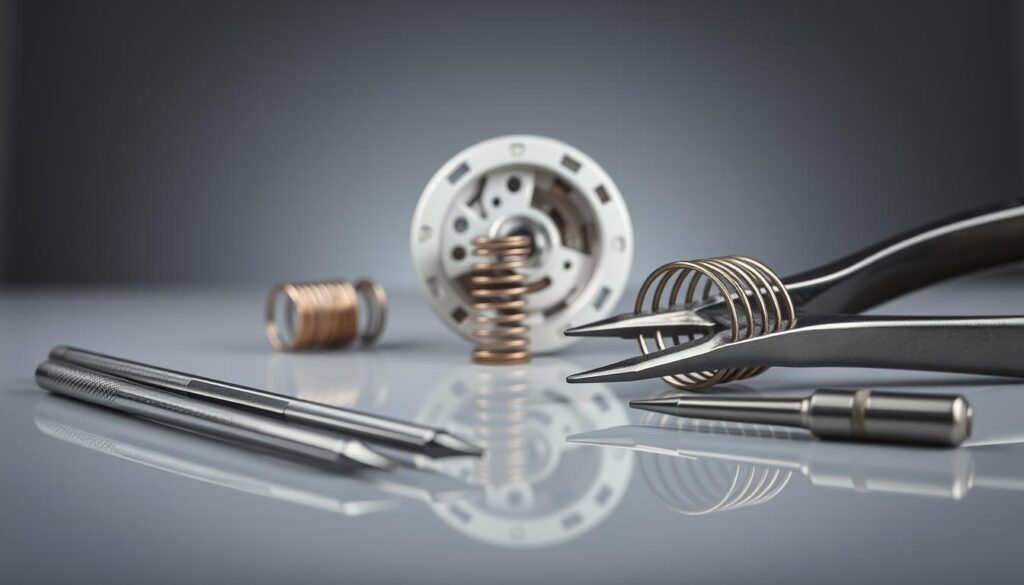Replacing a barrel spring is key to keeping equipment running well. Our guide makes this process easy, focusing on installing precision barrel springs right. You'll learn about the tools and safety steps needed to do it correctly. This is helpful for both newbies and experts working with machines or industrial systems.
Barrel springs are key parts in machines, offering vital support. They have a curved shape to absorb force and keep things stable. Keeping them well-maintained helps them last longer and avoids sudden failures.
Barrel springs are different because of their barrel-shaped coils. This shape helps them handle heavy loads without bending. They're used in industrial barrel springs for manufacturing, cars, and building machines.
Their curved shape spreads out pressure, making them less likely to break. This is why they're so important in heavy-duty equipment.
Replacing barrel springs when needed saves money and prevents big problems. Regular checks keep machines running longer and safer. Waiting too long can cause serious damage to equipment.
Fixing them early on protects your investment in heavy-duty gear.
Replacing a barrel spring needs the right tools for safety and accuracy. This section lists the tools for standard repairs and precision work.

For most repairs, you'll need pliers, screwdrivers, and spring compressors. Automotive or door hardware jobs require adjustable wrenches and torque drivers. Precision work needs micrometer gauges and hydraulic compressors for exact measurements. Here are the key items for each application:
Always wear eye protection and cut-resistant gloves. Springs can snap and release energy. Make sure your work area is safe with anti-slip mats and spring clamps. Safety gear is a must.
Professional tools make the job easier. Spring winding machines and laser calipers help with precision. Look for compressors from brands like Stanley or Craftsman for high-tension jobs. Quality tools reduce errors and make springs last longer.
Replacing a barrel spring needs careful steps for the best results. Follow these steps for a safe and effective installation:
“When installing custom barrel springs, always cross-reference dimensions with the original equipment manufacturer (OEM) drawings to avoid misalignment.” – Industrial Equipment Safety Association

Make sure the spring has the right tension during use. Reassemble the mechanism slowly, tightening fasteners to the right torque. After final assembly, run the system through its full range of motion. If using custom barrel springs, check if performance meets engineered tolerances. Fix any looseness or resistance right away to avoid early wear.
Choosing the right barrel spring is about finding the right balance. It's about performance and how long it lasts. This guide will help you pick the best spring for your needs.
High-quality barrel springs are tested more and made with better materials. They last longer and don't bend easily. Look for high-quality barrel springs that meet ASTM or ISO standards.
| Material | Best For | Key Advantage |
|---|---|---|
| Stainless Steel Barrel Spring | Food processing, marine equipment | Corrosion resistance, FDA compliance |
| Chrome Silicon | Aerospace, automotive | Heat resistance up to 600°C |
| Phosphor Bronze | Electrical contacts, precision devices | Non-magnetic, high conductivity |
When looking for springs, ask for quotes from barrel spring suppliers with ISO certifications. Ask barrel spring manufacturers for:
If you need springs for 10,000+ cycles a day, look for heavy duty barrel springs. Custom designs are key for unique sizes or loads. Always tell the manufacturer about your specific needs.
Keeping barrel springs in good shape is key for lasting equipment and safety at work. Regular checks and quick replacements stop expensive breakdowns. This is especially true in places where heavy-duty springs are always under stress.
Choosing the right parts from reliable suppliers like Spring Manufacturing Co. or Quality Spring Co. is important. Industrial springs in busy machines need regular checks to spot wear early. Keeping a log of when parts were replaced helps with future repairs.
Using top-notch materials like stainless steel helps springs last longer and resist corrosion. For special needs, talking to makers like Erie Spring or H.H. Spring gets your equipment just right. Taking care of springs now saves money by avoiding sudden failures that slow down work.
Learning about mechanical parts and working with suppliers helps keep things running smoothly. Sharing this knowledge with your team builds a culture of dependability. The right way to install and choose materials makes a big difference in how well things work over time.
Don't overlook the importance of regular checks and quality parts. Investing in barrel spring care today keeps things running well and saves money later.
We have many types of barrel springs. These include custom, heavy duty, and precision springs. Each is made for different loads and uses, ensuring they work well in many settings.
It's important to replace barrel springs when they show signs of wear. Look for damage, less tension, or odd performance. Regular checks help keep our systems safe and running smoothly.
Mostly, we use stainless steel springs for their resistance to corrosion and strength. In tough places, this is key. Sometimes, we use carbon steel or special alloys too, depending on what's needed.
Choosing the right barrel springs means buying from trusted makers. Look at the specs, material quality, and how they're tested. This ensures we're investing wisely.
To replace barrel springs, you'll need basic tools like pliers and screwdrivers. Also, spring compressors for safety and ease. Don't forget safety gear like gloves and eye protection to avoid injuries.
Yes, we make custom barrel springs for unique needs. By working with suppliers, we design springs that fit specific applications perfectly. This ensures they work well where they're needed.
Heavy duty barrel springs handle more stress and last longer. They're perfect for tough industrial jobs. Replacing them with quality springs can make equipment last longer and work better.